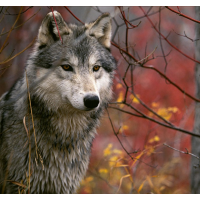Feds Want to Lift Protection for Gray Wolf, Dimming Prospect of California Return
 Gray wolf
Gray wolf
When a single gray wolf wandered into California two years ago from neighboring Oregon—after an absence of nearly 90 years—it inspired conservationists who hoped that the legally endangered species could reassert a foothold in the state.
That optimism was dimmed last week when the Obama administration proposed that the federal government remove protection for the gray wolf in the 42 states, including California, that still have it. The public will have 90 days to comment on the new proposal.
But the damage may already have been done.
More than 95% of the remaining wolves are in Montana, Wyoming, Idaho, Michigan, Minnesota and Wisconsin, where control was returned to the states in 2011. Since then, 1,100 wolves have been killed, reducing the population 7%, according to the Center for Biological Diversity.
“The recovery of the gray wolf is one of the most remarkable successes in the history of conservation,” Daniel M. Ashe, director of the U.S. Fish and Wildlife Service, told a press conference announcing the impending decision. He was touting the success of a program that sought to bring back a predator that once freely roamed the country, had been reduced to near extinction and now numbered around 6,100.
But conservationists think the move is premature. “This is like kicking a patient out of the hospital when they’re still attached to life support,” said Noah Greenwald, endangered species director with the Center for Biological Diversity.
Gray wolves remain scarce or non-existent in California, New England, upstate New York and parts of the Northwest where researchers say they would thrive if given a chance. In California, without federal protection, those chances are greatly reduced.
“We do not welcome the wolf back in California,” Jack Hanson, a cattle rancher in Lassen County and the treasurer of the California Cattlemen's Association, told the San Francisco Chronicle. “We would like to put a big shield up and keep him out, no doubt. . . . If there were no regulations, our family would shoot them on sight so that they did not multiply.”
Although hunters and ranchers find little to recommend keeping the wolves alive, conservationists have a different opinion. The disappearance of the wolves disrupted healthy ecosystems, according to environmentalists, but their return has provided a measure of restoration. In one instance, elks vacated lowlands and streams to avoid the wolves, allowing willow, aspen and cottonwood to grow back, according to the U.S. Fish and Wildlife Service. That provided food for beavers, habitat for songbirds and shadier streams for fish. Intimidated coyotes left the area, giving safer haven to small rodents and providing a boon to hungry carnivores that fed upon them.
The state Department of Fish and Wildlife has a web page devoted to the gray wolf, which seems odd to some because until December 2011 canis lupus had been absent from California since 1924. But hope springs eternal or, at least, for a little while.
“Whether one is for it or against it, the entry of this lone wolf into California is a historic event and result of much work by the wildlife agencies in the West,” Department of Fish and Wildlife Director Charlton H. Bonham said at the time. “If the gray wolf does establish a population in California, there will be much more work to do here.”
The “if” will get a lot bigger if the administration has its way.
–Ken Broder
To Learn More:
Plan Lifts Lower 48 Wolf Protections (by Matthew Brown and John Flesher, Associated Press)
Federal Protection of Gray Wolves May Be Lifted, Agency Says (by Felicity Barringer, New York Times)
Obama Administration Strips Wolf Protections Across Most of Lower 48 States (Center for Biological Diversity)
Don’t Forsake the Gray Wolf (by Jim Dutcher, Jamie Dutcher and Garrick Dutcher, New York Times op-ed)
Wolf's Entry into Calif. Major Environmental Step (by Peter Fimrite, San Francisco Chronicle)
- Top Stories
- Controversies
- Where is the Money Going?
- California and the Nation
- Appointments and Resignations
- Unusual News
- Latest News
- California Forbids U.S. Immigration Agents from Pretending to be Police
- California Lawmakers Urged to Strip “Self-Dealing” Tax Board of Its Duties
- Big Oil’s Grip on California
- Santa Cruz Police See Homeland Security Betrayal in Use of Gang Roundup as Cover for Immigration Raid
- Oil Companies Face Deadline to Stop Polluting California Groundwater





